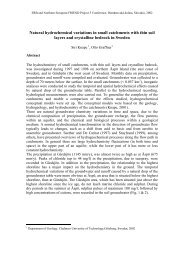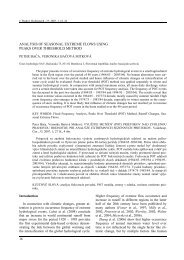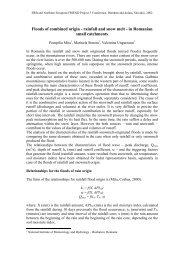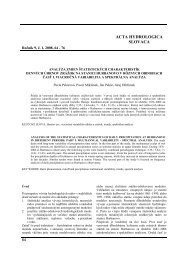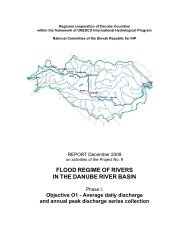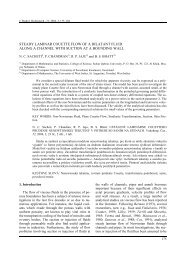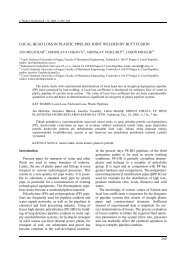TIME SERIES ANALYSIS OF HYDROLOGIC DATA FOR WATER ...
TIME SERIES ANALYSIS OF HYDROLOGIC DATA FOR WATER ...
TIME SERIES ANALYSIS OF HYDROLOGIC DATA FOR WATER ...
You also want an ePaper? Increase the reach of your titles
YUMPU automatically turns print PDFs into web optimized ePapers that Google loves.
D. Machiwal, M. K. Jhaexpected to occur by chance. There were differencesin the geographic location of significanttrends in the hydrologic variables, which indicatedthat the climatic impacts were not spatially uniform.Yu et al. (2002) investigated the impact of climatechange on the water resources of the Kao-PenCreek Basin in southern Taiwan. The historicaltrends of salient meteorological variables (i.e.,mean daily temperature, mean daily precipitationon wet days, monthly wet days, and the transitionprobabilities of daily precipitation occurrence ineach month) were detected using the nonparametricMann-Kendall Test. The trends of these meteorologicalvariables were then employed to generaterunoff under future climatic conditions using a continuousrainfall-runoff model. The results indicatedthat the transition probabilities of daily precipitationoccurrence significantly influence the precipitationgeneration, and the generated runoff underfuture climatic conditions was found to increaseduring the wet season and decrease during the dryseason.5.4 EvapotranspirationZaninovic and Gajic-Capka (2000) analyzed thevariations and trends in some water balance componentsviz., soil water content, evaporation lossesfrom the surface and subsurface soil layers, transpiration,groundwater recharge, and runoff. Thesecomponents were calculated by the Palmer methodusing the 1900 – 1995 data from Osijek, Croatia.Besides the meteorological inputs necessary for thewater balance calculation (i.e., precipitation, temperatureand relative humidity), the pedologicalcharacteristics of this area was also taken into account.Fluctuations were accounted for by considering11-year binomial filtered series and the lineartrends were tested by the Mann-Kendall Rank Test.A progressive analysis of the time series was alsoperformed to obtain better insights into the trendsof water balance components. The results suggesteda significant increase in the potential evapotranspirationand evapotranspiration, but a decrease in therunoff and soil-water content during the twentiethcentury.Hobbins et al. (2001) analyzed the annual andseasonal trends in a monthly time series of actualevapotranspiration using the Mann-Kendall Testwithin the context of the complementary relationshipon a regional basis to establish that regionaltrends can be determined to originate in either theenergy budget or the water budget, or both. Themonthly time series of 27 years at a 5-km resolutionover the conterminous United States was created byusing a regional, seasonal Advection-Ariditymodel, which provided a tool for studies on climatechange and variability based on comparison of intra-annualtrend results with results from anotherstudy.6. Application of time series analysisin surface water hydrology6.1 StreamflowLye and Lin (1994) analyzed the peak flow seriesfrom 90 Canadian rivers to examine stationarity.The results suggested that although short-term dependenceis practically absent for most peak flowseries, significant long-term dependence is presentfor a large number of peak flow series tested. It wasdemonstrated that the most statistical tests of independenceor stationarity are designed to detect onlyshort-term serial correlation. They were found insensitiveto the long-term serial correlation structureof flood records, which can be far more important.Lins and Slack (1999) determined secular trendsin the streamflows of 395 climate-sensitivestreamgaging stations in the conterminous UnitedStates by the nonparametric Mann-Kendall Test.Trends were calculated for the selected quantiles ofdischarge [0 th ] to [100 th percentiles] to evaluate thedifferences between low-, medium-, and high-flowregimes during the twentieth century. Two generalpatterns emerged: (i) trends are most prevalent inthe annual minimum (Q 0 ) to median (Q 50 ) flowcategories and least prevalent in the annual maximum(Q 100 ) category; and (ii) at all but the highestquantiles, streamflow has increased across broadsections of the United States. The decrease instreamflow was found only in parts of the PacificNorthwest and Southeast. Systematic patterns wereless apparent in the Q 100 flow. Hydrologically, theseresults imply that the conterminous U.S. is gettingwetter.Douglas et al. (2000) evaluated trends in theflood and low streamflows of the US by using aregional average Kendall's S Trend Test at twospatial scales and over two timeframes. The fieldsignificance was assessed following a bootstrapmethodology to account for the regional crosscorrelationof streamflows. The flood flow series wasfound trend-free at 5% level of significance, but248



